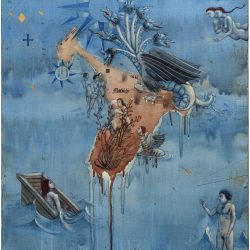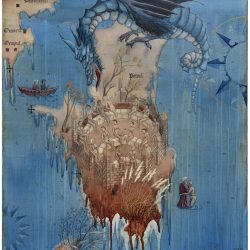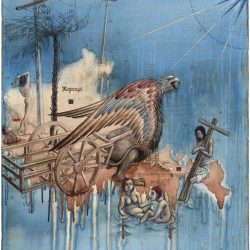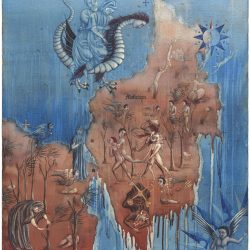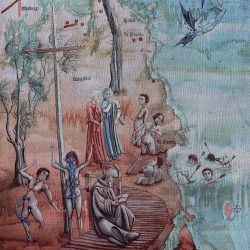Roger Mortimer | Hauraki: Northerly Wind
Roger Mortimer‘s extraordinary new exhibition: Hauraki: Northerly Wind is comprised of four beautiful jewel like paintings, which are exhibited alongside Roger’s largest work to date – a 7.5 meter jacquard weaving.
The four smaller paintings, despite their relative size to the giant weaving hold their own in its presence. These beautifully painted works are radiant objects that exude the brilliance of a misty light, giving these paintings real depth – both illusionistically and conceptually. Inky washes of watercolour and rubbed gold dust have been carefully built up in translucent layers, so not to lose the delicate hand of Roger’s initial line work, which is reminiscent of the intricacy & perspective of Persian miniatures and Japanese prints.
The paintings are all set on small islands within the Hauraki Gulf and the scenes represented at these locations are typically overrun with illuminations and happenings from medieval manuscripts of Dante’s Divine Comedy. Unusually for Mortimer’s work, the chaotic disorder and violence of Dante’s narrative is softened in these smaller works – which are all bloodless, without gore and overt gratuity. That said, it is perhaps notable with the intensity of Mortimer’s new palette, it is now the earth-red soil of the land which drips and bleeds into the ocean, while the washes and drips of the phthalo blue skies seem to almost weep onto the scenes below.
Hauraki ii
by Jade Kake (2022)
“The image is revealed in parts, emerging from each detail. Smaller details are visible at first. There are many unique features within these images. The eyes flit from one object to another, like the movement of a pīwakawaka. Most of the symbols are drawn from Dante’s poem Divine Comedy, from Italy, from Europe. Secondly, the viewer begins to see more details from New Zealand. Perhaps, it is possible to recognise the form of the land, from Muriwai to the west on the left side of the image, to the eastern side of the Hauraki on the right side. It is possible to see Māori names, proper names, of places: some common names, some unfamiliar ones.
The experience of seeing this work of art in the physical world is truly awe-inspiring on account of its sheer size. The images are divided across five panels, and the total width of the artwork is seven and a half meters. In the creation of this masterpiece, Mortimer has experimented with several new processes. This work of art represents a broadening of his artistic practice – and also a departure. In this context, the original paintings operate as models or maquettes for larger finished works, the paintings half the size of the woven panels.
The process of creating these new images represents an extension of Mortimer’s artistic process. He is no stranger to the digital medium, but this process is new. To begin with, Mortimer paints on canvas – a special primer on the bottom, then watercolour pigment on top. Because of the nature of the paint used, the drops drip down the canvas, achieving a painterly quality. To prepare these images for the digital process, Mortimer limits his selection to three colours. Once completed, the paintings are photographed and the image file is reworked on the computer and then sent to the textile specialist, who then weaves Mortimer’s paintings into the fabric using a process known as Jacquard weaving.
Throughout his career, Mortimer has sought answers to these important questions – How is Pākehā identity defined in New Zealand? What are some of the characteristic of the emergence of a distinct style or movement of Pākehā art? Mortimer’s work can be described as a confluence; to use a Māori metaphor – ‘he tai whatiwhati rua’, a meeting of two ideas: of Pākehā genealogy and knowledge (from the whakapapa of artist), and the whakapapa and mātauranga of this country here, the place of Mortimer’s birth and his life. Perhaps that is the essence of his work as a European artist working in New Zealand”.
________________________
“Ka whakakitea te ahua i ngā wāhanga, putaputa mai i tēnā taipitopito. Ka kitea ngā taipitopito iti iho i te tuatahi, ngā āhuatanga motuhake kei roto i ēnei mahi toi. Ka tītakataka ngā karu mai i tētahi mea ki tētahi atu mea, pēnei te neke o te tīrairaka. Ko te nuinga o ngā waitohu ka takea mai i te rotarota a Dante a Divine Comedy, nō Itaria, nō Ūropi. I te tuarua, ka tīmata te mahi toi ki te whakaatu i ētahi atu taipitopito mai i Aotearoa. Tērā pea, ka taea te āhukahuka i te auaha o te whenua: mai i Muriwai ki te uru, ki te taha mauī o te mātātuhi, ki te taha rāwhiti o Te Tara-O-Te-Ika-A-Māui ki te taha matau. Ka taea te kite i ngā ingoa Māori, ngā ingoa tika, o ngā wāhi: ētahi ingoa noa, ētahi ingoa tauhou.
He tino wewehi te wheako o te kite i tēnei mahi toi i te ao kikokiko nā te rahi i ēnei. Kua whakainatitia ngā whakaahua ki ngā pānui e rima, ā ko te whanui katoa o ngā mahi toi e ono ngā mita. I te hanga o tēnei mea nui, kua whakamātau a Mortimer i ētahi hātepe hou. Ko tēnei mahi toi he tohu mā te whakawhanui o āna whakaharatau toi – me te wehetanga hoki. I tēnei horopaki, ko āna peita taketake hei tauira mā ngā mahi nunui kua oti – ko te nui o ngā peita, he haurua te nui o ngā paewhiri raranga.
Ko te hātepe o te hanga o ēnei whakaahua hou, he tohu mā te whakawhanui o te hātepe toi a Mortimer. Ehara ia i te waewae tapu ki ngā rawatoi matihiko, engari, he hou tēnei hātepe. Ki te tīmata, ka peita a Mortimer ki runga i ngā kānawehi – ko te peita kiriwai motuhake ki raro, kātahi ka te peita waikano ki runga. Nā te āhua o te peita i whakamahi ai, ka māturuturu ngā pata ki raro i te kānawehi, ka whakatutukia te āhuatanga peita. Hei whakarite i ēnei whakaahua mā te hātepe matihiko, ka whakawhāitihia e Mortimer āna tīpako ki ngā tae e toru. Ka oti ēnei mahi, ka whakaahuahia ngā peita, ka rāwekeweke ngā kōnae ata, ka tukuna ki te kaihanga kakano, kātahi ka rānga ngā peita a Mortimer e te kaihanga i te papanga mā te hātepe i te tikanga e kīa nei ko te rāranga Jacquard.
Mā te katoa o tāna umanga, kua whai a Mortimer i ngā whakautu ki ēnei pātai whakahirahira – he aha te tuakiri Pākehā kei Aotearoa? He aha ētahi āhuatanga kōhure o te puta mai o te tāera kōhure, o te rangatohe rānei, o ngā toi a te Pākehā? Ka taea te whakaahua te mahitoi a Mortimer hei komititanga; ki te whakamahi i tētahi kupu whakarite Māori – koinei he tai whatiwhati rua, he tūtakitanga o ngā whakaaro e rua: o te whakapapa me te mātauranga Pākehā (mai i te whakapapa o te ringatoi), me te whakapapa me te mātauranga o tēnei whenua ki kōnei, te wāhi o te whānau mai me te oranga a Mortimer. Tērā pea koirā te ngako o tāna mahi hei ringatoi Pākehā e mahi nei ki Aotearoa”.
